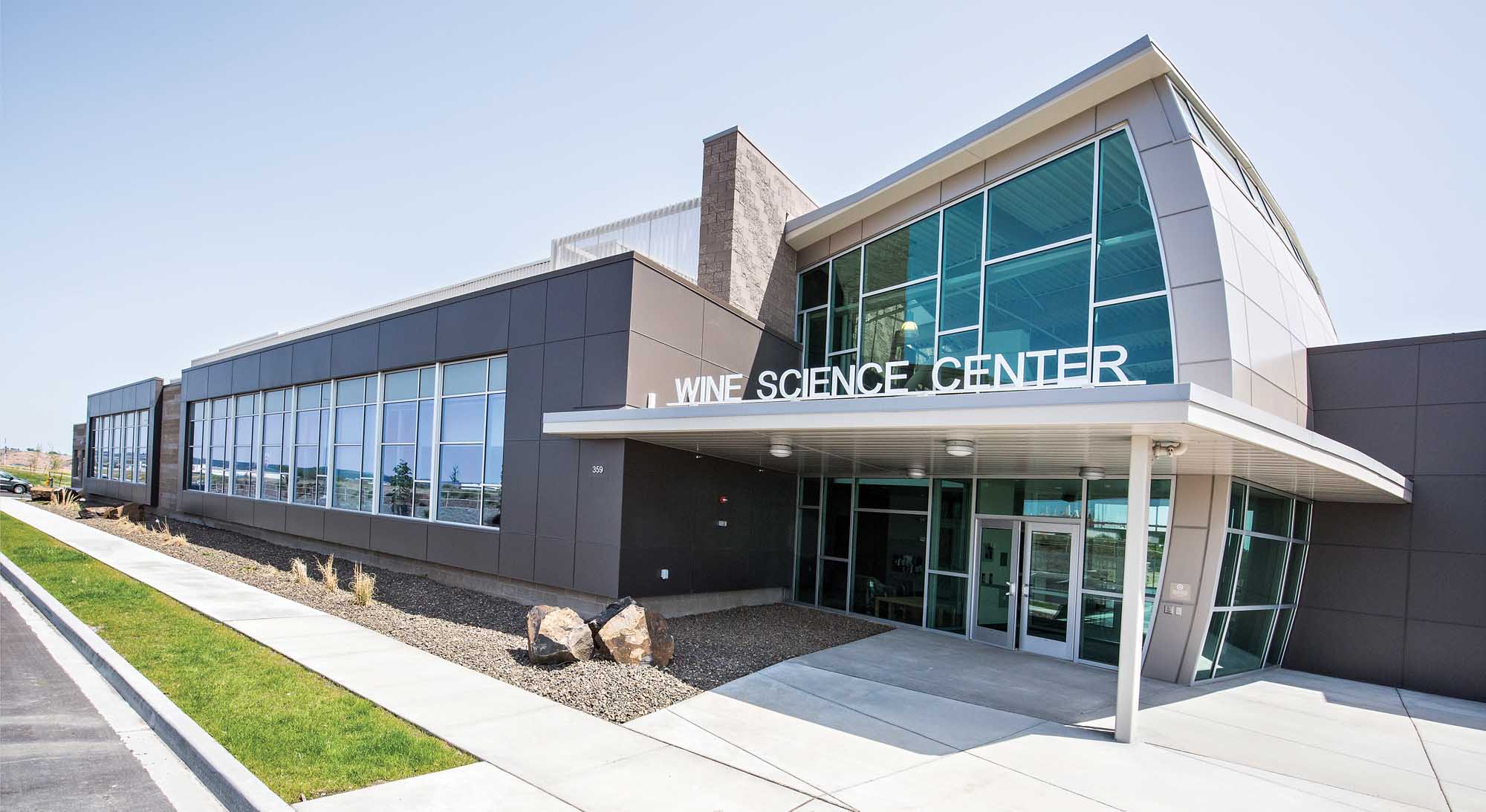
Final preparations are made on May 4, 2015 to complete and open the new Washington State University Wine Science Center in Richland, Washington. The center, located near the Tri-Cities campus of WSU, will be a hub for the Washington wine industry and bring together researchers, students, and industry members. (TJ Mullinax/Good Fruit Grower)
The new Wine Science Center at Washington State University Tri-Cities and its state-of-the-art research and teaching winery has seasoned vintners and winemakers wishing they were back in school.
A grand opening for the wine center is scheduled for June 4. Good Fruit Grower toured the facility as crews put on the finishing touches and faculty and researchers moved in. Students will fill the classrooms, labs, and hallways in August when fall semester begins.
“I wish this had been here when I was in school” is one of the most frequent comments of visitors taking a tour of the center, said Erika Holmes, communications director for WSU’s viticulture and enology program. Holmes has given countless tours during the two years of the facility’s construction phase.
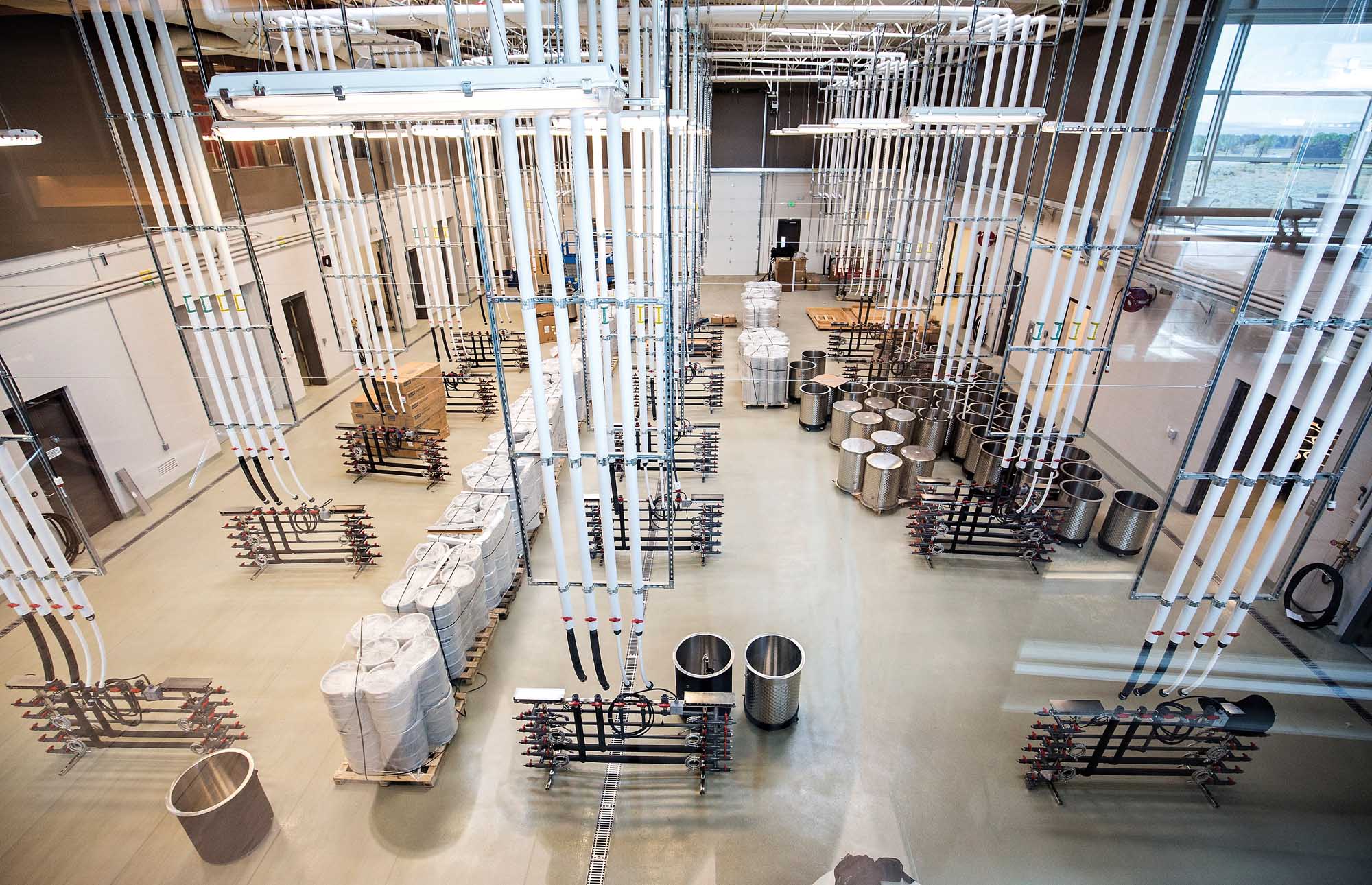
The Washington State University Wine Science Center’s 6,000 square-foot research and teaching winery will feature 192 stainless steel tanks and thousands of feet of hot and cold piping for high-tech fermentation. The fermentation system is the second of its kind built. (TJ Mullinax/Good Fruit Grower)
The wine center makes WSU home to one of the world’s largest and most technologically advanced wine research and teaching facilities. It puts the state’s wine industry on the global map of wine.
In seven years, the center went from being an unfunded conclusion in a report on industry research needs to a 40,000 square-foot research and teaching showcase. The center will help attract the best and brightest wine students and researchers in the world.
In 2008, a report commissioned by the Washington wine industry concluded that the existing WSU research and teaching facilities, scattered between Pullman, Tri-Cities, and Prosser, were “inadequate to conduct the research needed by the industry for today and tomorrow.”
But just as the concept for a world-class research and teaching center started to gain traction within the wine industry and WSU, the recession put a stop to such projects.
Industry vision
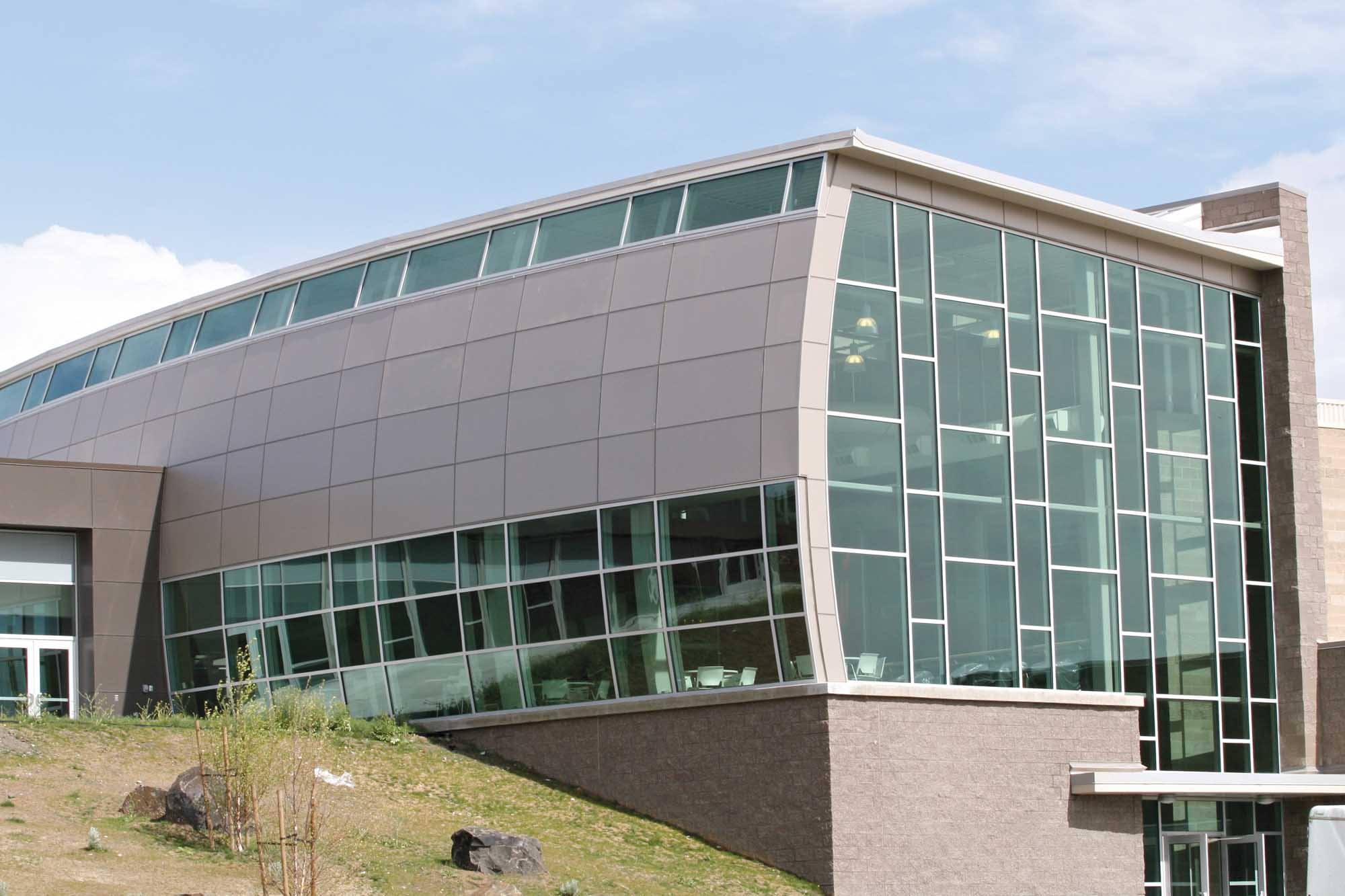
The center’s atrium is designed to resemble a wine barrel. (Melissa Hansen/Good Fruit Grower)
About five years ago, the wine industry got serious about it, says Ted Baseler, chief executive of Ste. Michelle Wine Estates, Washington’s largest wine producer.
The wine industry, through the Washington Wine Commission, jumpstarted the project by pledging $7.4 million of grower and winery money and helped form partnerships between WSU, the Richland community, and the Port of Benton.
Funding for the $23 million center has come from a mix of industry contributions and state and federal funds and grants.
“Virtually all the leaders of the wine and grape industry agreed there was an acute need for world class science, and people quickly rallied around the effort to build the center,” said Baseler, who chairs the WSU Wine Campaign Committee. “Now, it seems even more important than ever.”
Construction of the wine center took less than two years. The Port of Benton donated land near the WSU-Tri Cities campus, and the City of Richland created an economic development authority to oversee construction and financing, a role typically assumed by the college. The city recently turned over the building to WSU.
Baseler said that with recent commitments, the building is fully funded and only another $1.5 million is needed for equipment. “That is huge progress given the starting goal of $23 million. I want to thank all who have generously supported this critical project.”
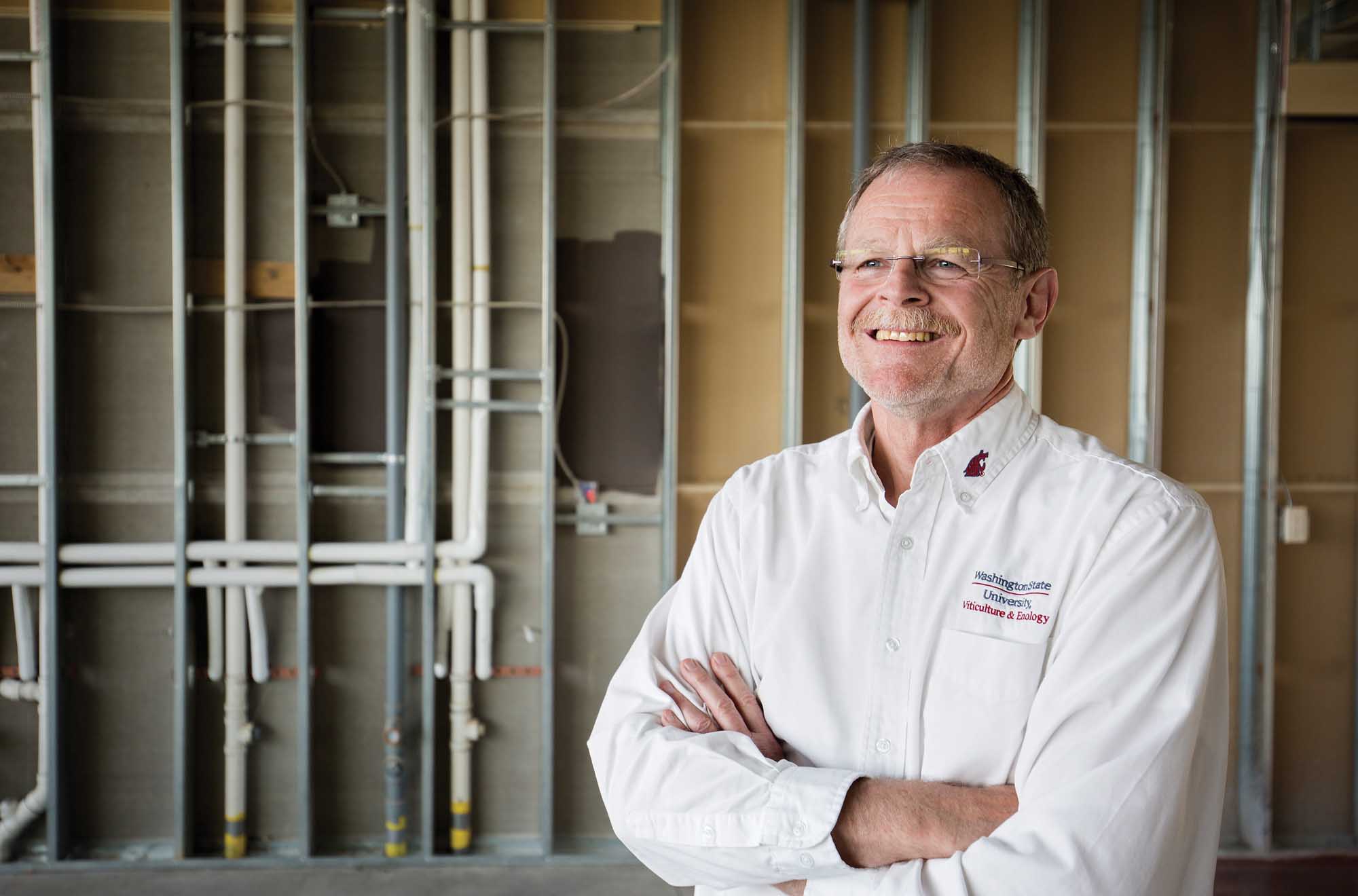
Thomas Henick-Kling stands in an unfinished classroom in the new Washington State University Wine Science Center on May 4, 2015 in Richland, Washington. Henick-Kling is WSU’s director of viticulture and enology. (TJ Mullinax/Good Fruit Grower)
When Dr. Thomas Henick-Kling came to WSU in 2009 to lead the viticulture and enology program, one of the things that attracted him from Australia was the industry’s vision of a wine and research center.
“It is as exciting today as it was then,” he said in an email to Good Fruit Grower while leading a study tour in France. “It’s exciting that the Washington wine industry has such foresight and so many dedicated people who will work together to develop a vision and make it happen.”
Unique features
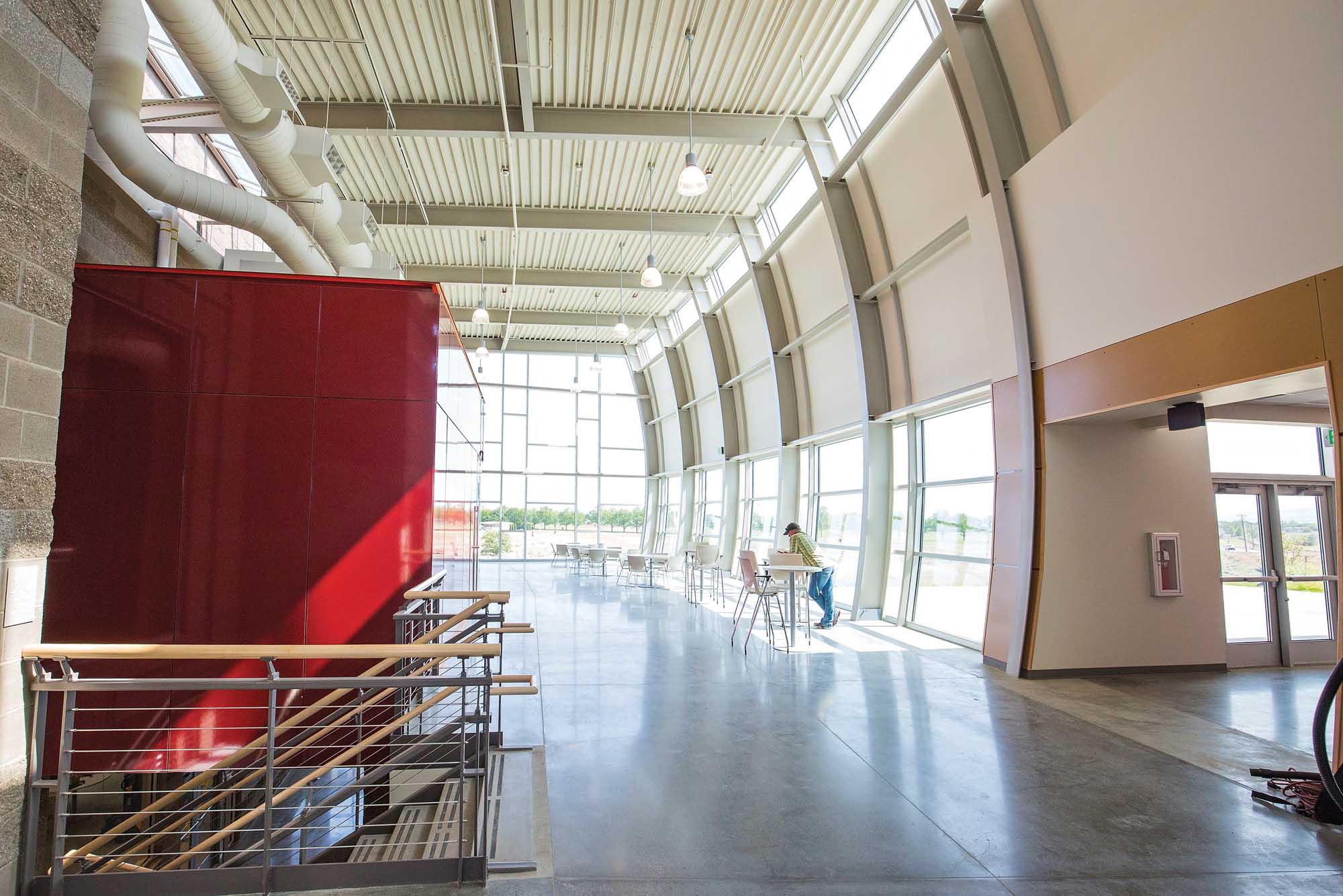
The Washington State University Wine Science Center atrium has a view of a teaching vineyard and provides room for students to gather.
(TJ Mullinax/Good Fruit Grower)
The facility provides space for the viticulture and enology program for educating future generations and will serve as a hub for researchers. It will be able to house about 60 faculty, staff, and students, according to Henick-Kling. But more importantly, it provides critical research space for the viticulture and enology program that was not available anywhere in the WSU system.
“This new center will allow us to start new and innovative research,” he said, and added that it also supports current projects at WSU’s research center in Prosser and at the main campus in Pullman. “Our strengthened research program, together with our expanded education programs, will ensure the future competitiveness and success of the Washington wine industry.”
Now that he has additional room, Henick-Kling will soon have a new wine chemistry position filled, bringing the initial faculty number to six in the new building. There’s room for one more faculty member and lots of space for visiting scientists, post doctorates, and graduate students.
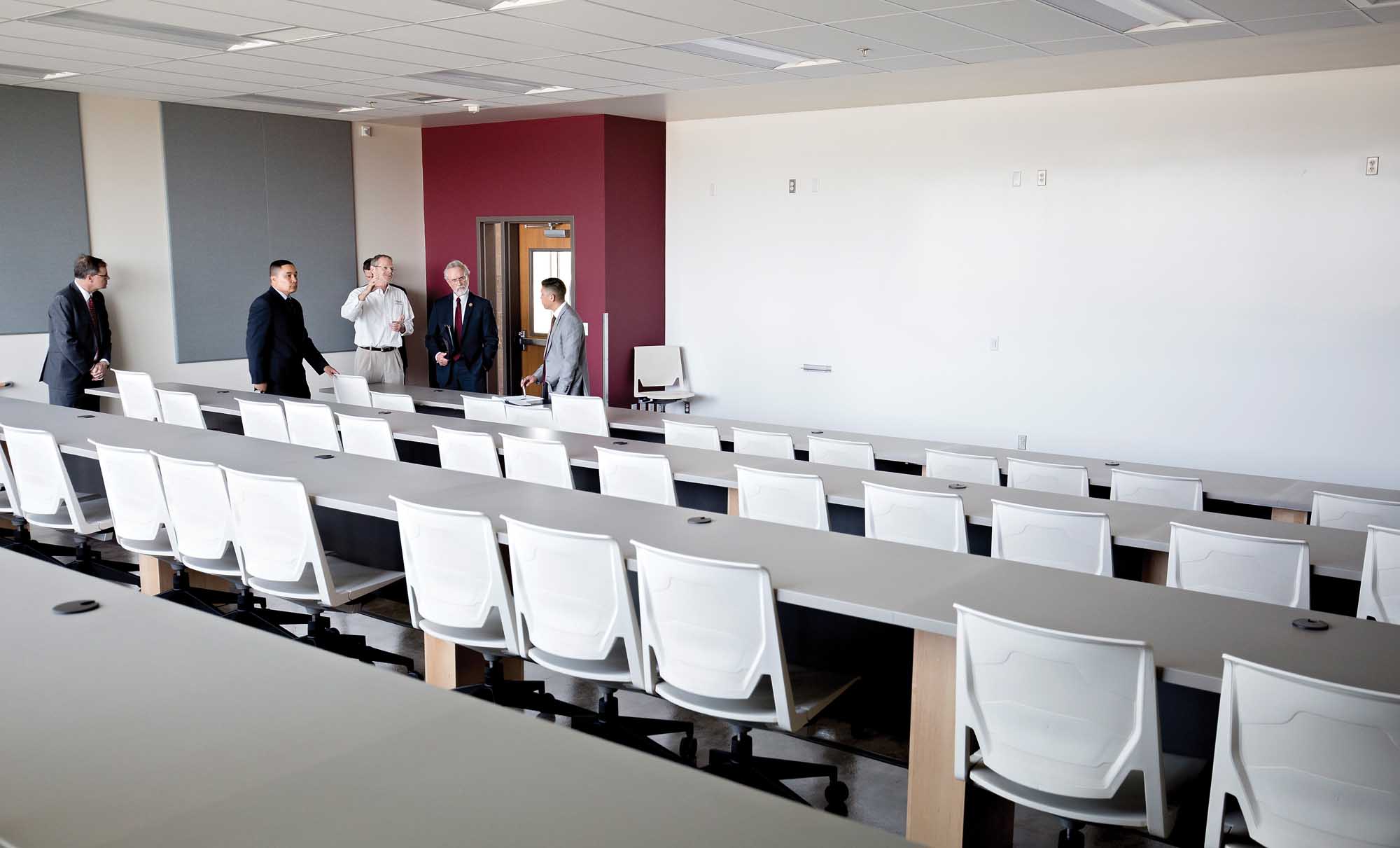
Thomas Henick-Kling, wearing white, leads a tour of the new Washington State University Wine Science Center to U.S. Rep. Dan Newhouse on May 4, 2015. This room offers live video conferencing for students to evaluate wine between educational institutions, growers and winemakers across the globe.(TJ Mullinax/Good Fruit Grower)
Completion of the center comes at a critical time in the state’s wine industry trajectory, says Steve Warner, president of the Wine Commission. “The wine industry is very healthy and has grown an average of 35 percent across all categories in the five-year period from 2009 to 2013,” he said.
Although wine sales data for 2014 are not yet available, Washington grape growers produced a record crop of 227,000 tons last year, which represented an increase of 8 percent from 2013.
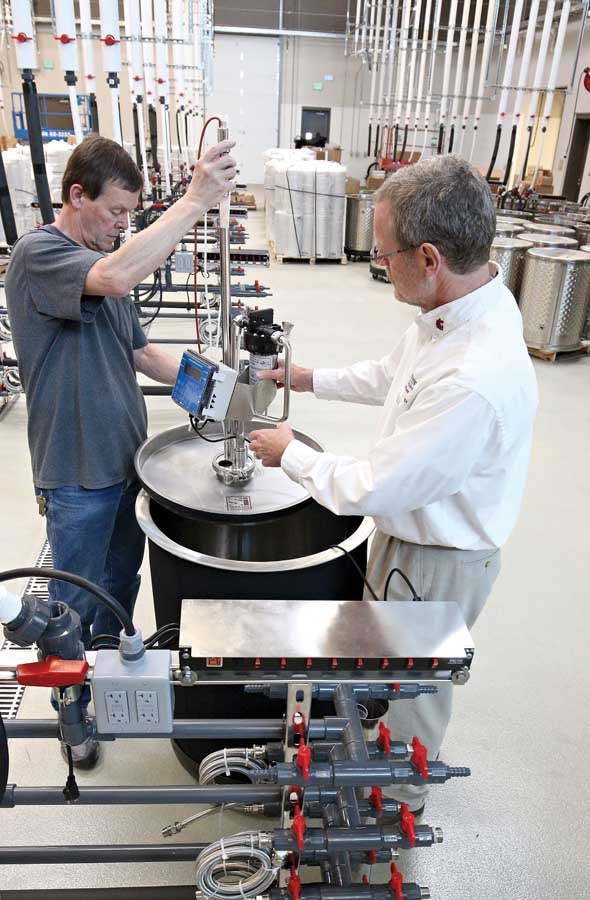
Washington State University research winemaker Richard Larsen, left, and Thomas Henick-Kling temporarily ssembles a state-of-the-art fermentation system in the center’s winery. The system includes automatic pumps for pump-overs. (TJ Mullinax/Good Fruit Grower)
Warner noted that Washington wine sales in 2013 totaled $1.5 billion, up from $1.07 billion in 2009, and 850 wineries produced 14.8 million 9-liter cases in 2013, up from 650 wineries and 10.8 million cases in 2009. The industry’s compounded annual growth rate the last five years has been around 8 percent.
“The Wine Science Center will take us to the next level that’s needed to compete in the hypercompetitive world of wine,” he said. “Research that comes out of the center will help improve vineyard and winery practices that benefit the entire industry, no matter the size of the grower or winery.”
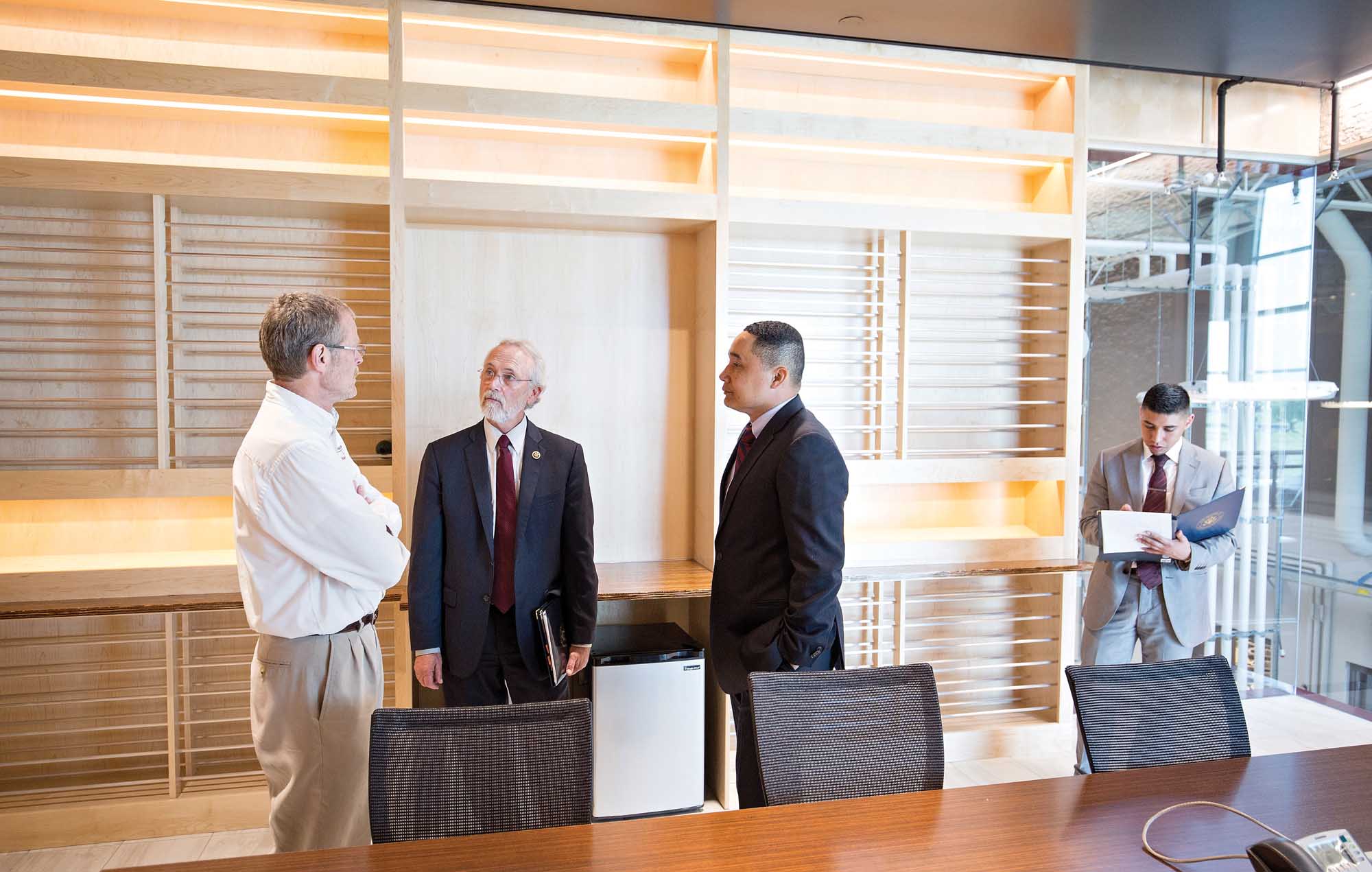
Thomas Henick-Kling, left, talks with U.S. Rep. Dan Newhouse, center left, on May 4, 2015, during a tour of the new Washington State University Wine Science Center. This room is the wine library room for meetings and tastings. (TJ Mullinax/Good Fruit Grower)
Moreover, Warner believes the state-of-the-art facility will help attract and retain the brightest minds. “We need the best minds to help agriculture find solutions to problems like grapevine diseases, new and invasive pests, as well as problems faced by winemakers.”
Baseler added that every great wine region has a scientific center of excellence. “Now, we do, too,” he said. “This will turn out well-trained leaders that will be the future for our industry. It will be a steeple of excellence for WSU and an economic driver for the state.”
The facility
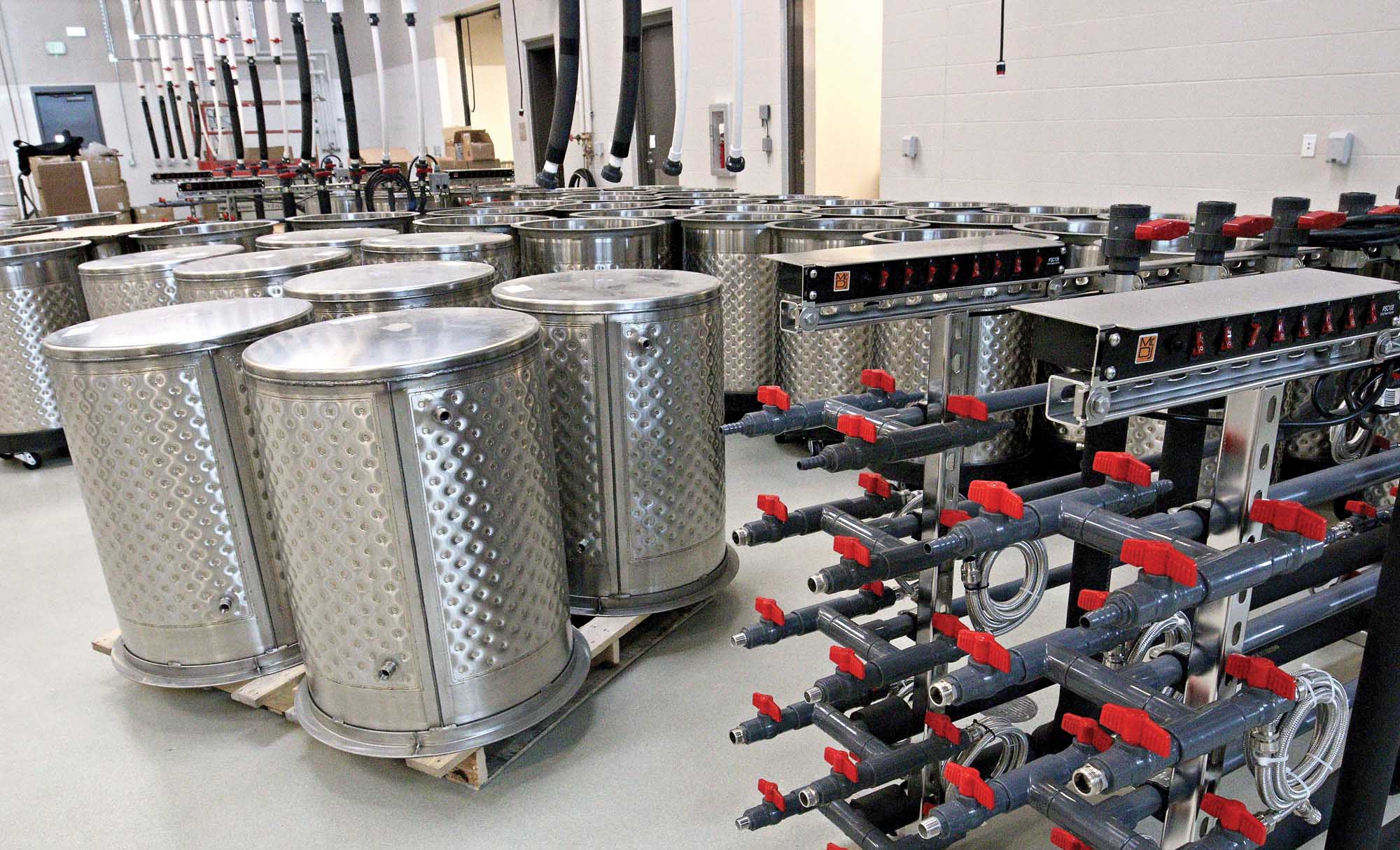
Some of the 192 climate-controlled, stainless steel research fermenters before they are assembled at the Washington State University Wine Science Center in Richland, Washington on May 4, 2015. (TJ Mullinax/Good Fruit Grower)
The center has a 6,000 square-foot research and teaching winery with nearly 200 small stainless steel tanks and thousands of feet of piping for climate control.
The fermentation system designed by Cypress Semiconductor Corp. of San Jose, California, is the second of its kind in the world and is the same system Cypress designed and built for the University of California at Davis. Having the same system as UC Davis offers potential for close collaboration between the two universities.

The Washington State University Wine Science Center wine library includes wood racks that will be filled with wine bottles. (TJ Mullinax/Good Fruit Grower)
Each tank holds 52 gallons and can be individually heated and cooled, enabling precise temperature control. Individual control units in each tank collect sugar concentration and temperature from three temperature sensors every 15 seconds and have ports for additional data collection in the future, such as tannin levels.
Each unit has a remote-controlled pump for automatic pump-overs to mix fermenting wine. Data is wirelessly transmitted to a central computer, which allows researchers to track and record multiple fermentations simultaneously.
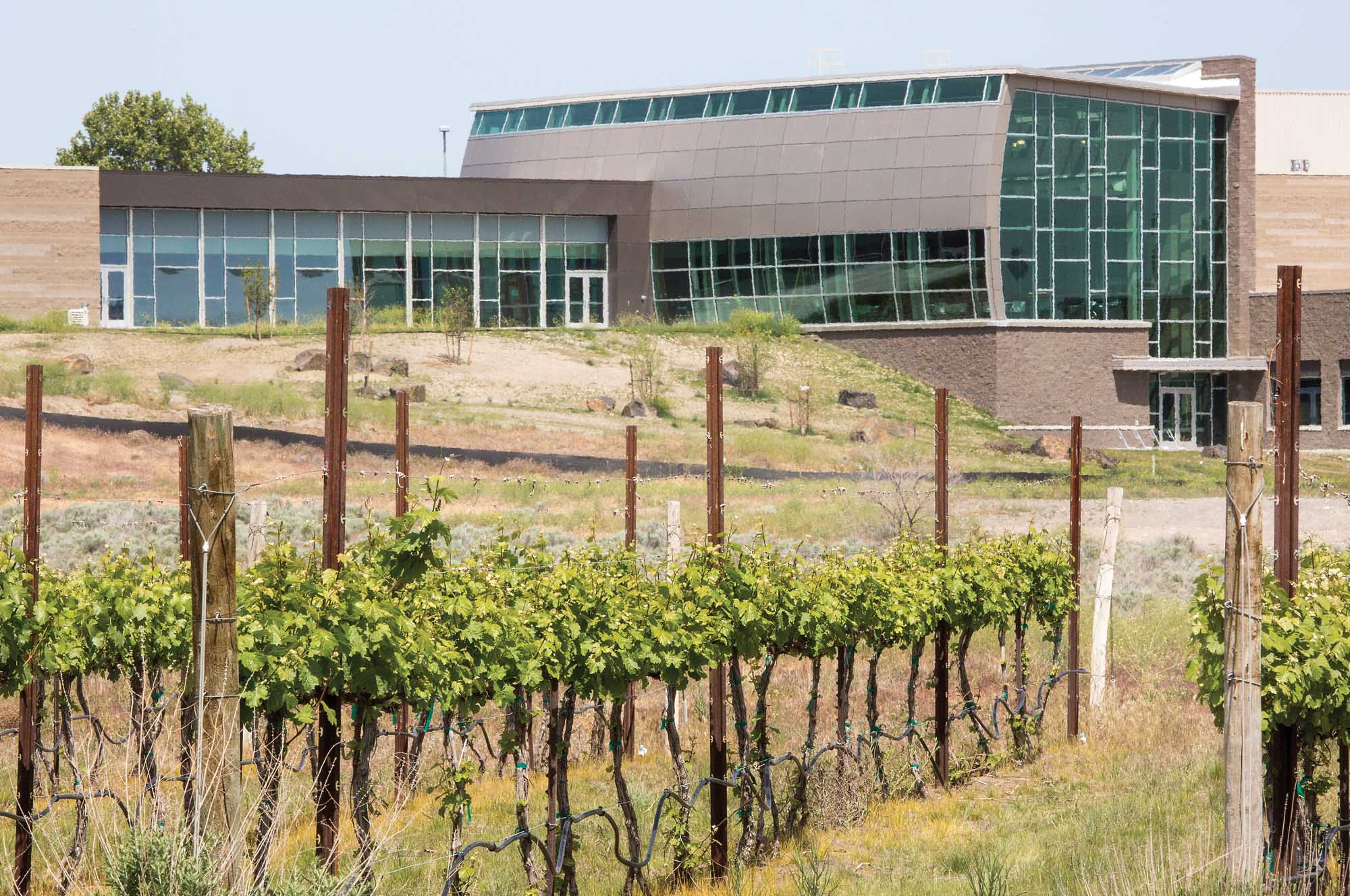
A small teaching vineyard, on the south side of the Washington State University Wine Science Center, helps students learn hands-on techniques, like pruning. (TJ Mullinax/Good Fruit Grower)
Other unique spaces in the facility include:
—Crush pad designed to receive morning sun—not hot afternoon exposure. It will include a high-tech WECO optical sorter to remove stems and other unwanted material from grapes before crushing. A refrigerated room allows researchers to store grapes if needed.
—Open atrium reminiscent of a wine barrel featuring a regional wine library to be used for educational wine tasting and seminars.
—Sensory evaluation and training facility, including dedicated gas chromatography room where specific odors can be made and identified to help train sensory panelists.
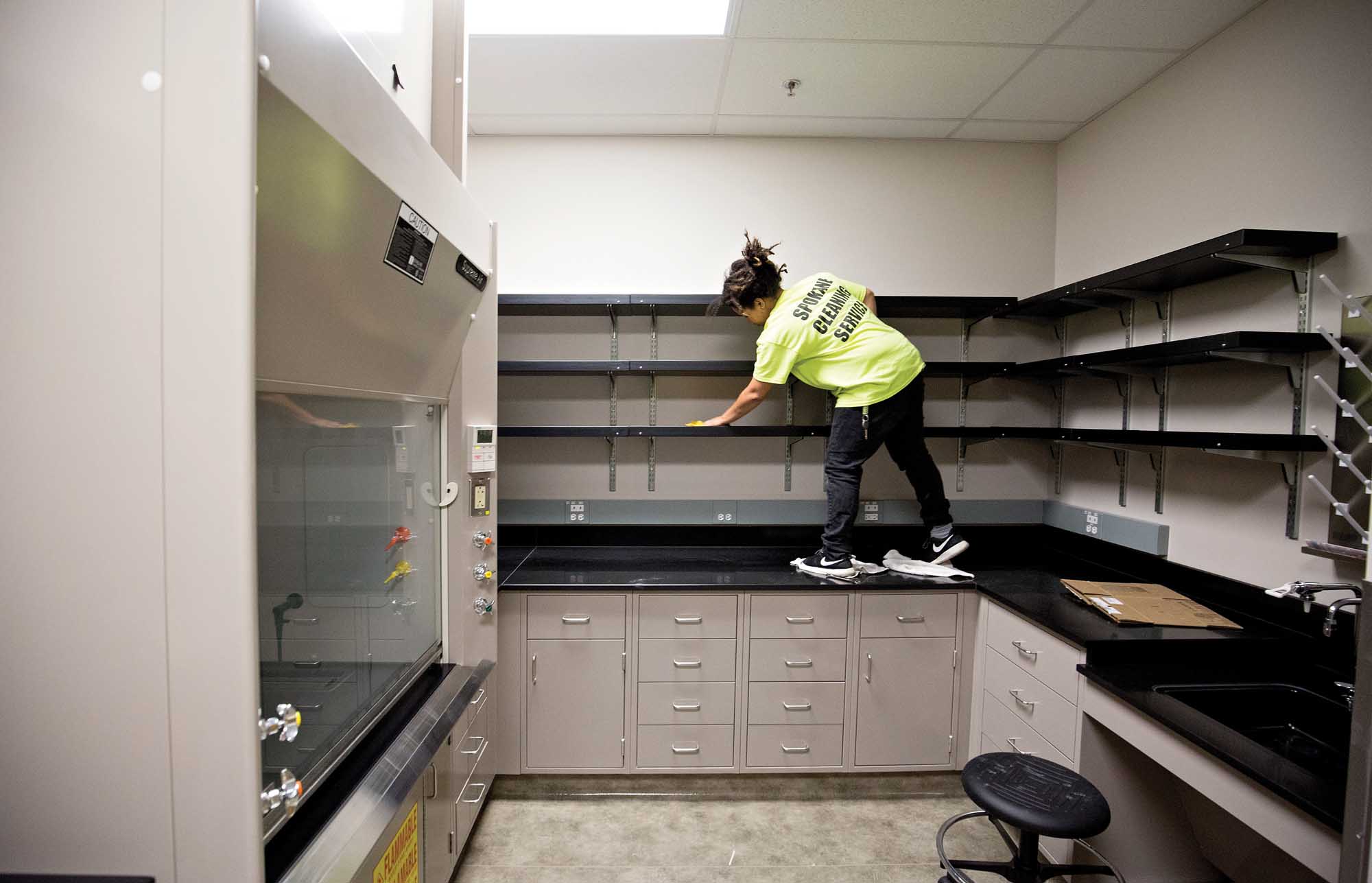
Asia Porter wipes dust from a lab, on May 4, 2015, completing the construction of the new Washington State University Wine Science Center in Richland, Washington. The center, located near the Tri-Cities campus of WSU, will be a hub for the Washington wine industry and bring together researchers, students, and industry members. (TJ Mullinax/Good Fruit Grower)
—Analytical chemistry, molecular biology, and life sciences labs to support plant pathology, plant physiology, and microbiology research.
—Seminar rooms, teaching lab, and classrooms specially designed to teach enology.
—Three growth chambers for studying cold hardiness and heat tolerance of grapevines under temperatures of -30°F to 150°F, and various light and watering levels that will be used in research to improve viticultural practices.
—Two greenhouses and storage building to support greenhouses.
—A research and teaching vineyard of 2.5 acres to give students hands-on learning opportunities and provide vines for small-scale experiments.
—Basalt rock and steppe shrub and native plants garden to illustrate eastern Washington’s climate and soils. •






Leave A Comment